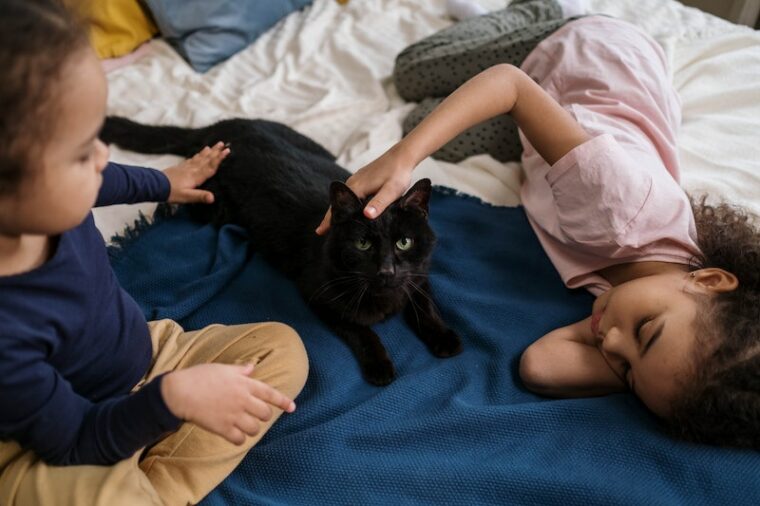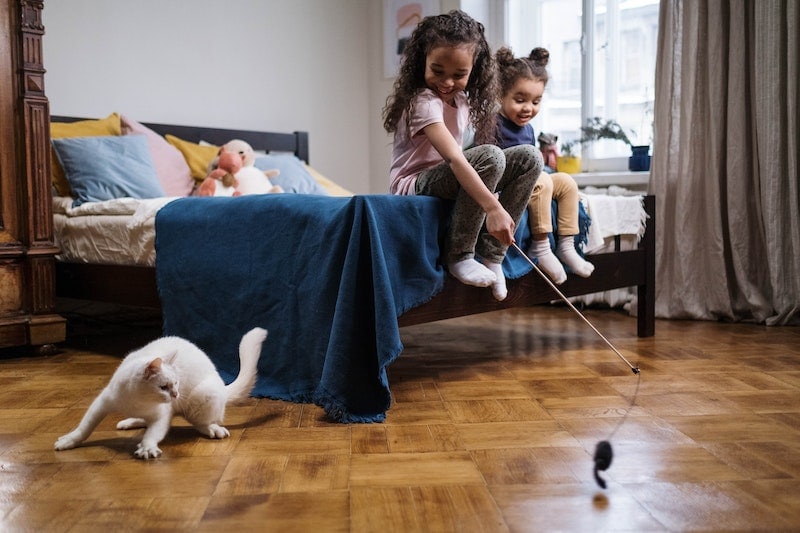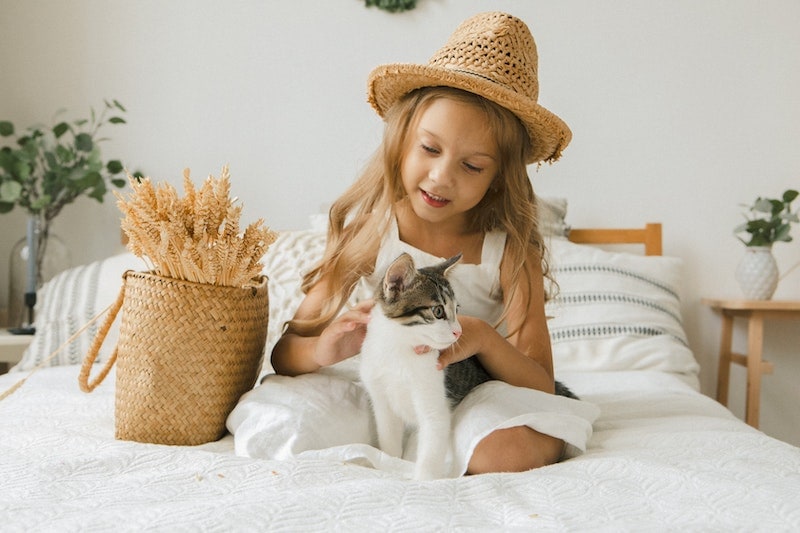
Many people love their children and their cats, and having a harmonious household where cats and kids live together in peace and happiness is the dream of many parents. But getting to that point is not always easy. Cats can have strong preferences and personalities, and children can be unaware of how their actions can affect a small cat. If you are planning on getting a new cat or are having trouble getting your kids and your cats to properly bond you are not alone. The good news is that there are plenty of ways to help your kids and your cats understand each other better and create a lasting bond.
Here are our tips to help promote bonding between cats and children.

The 11 Tips to Promote Bonding Between Cats and Children
1. Don’t Force Anything
It is tempting to try to force your kids and your new cat to fall in love with each other right away, but this is the wrong move. Bonding takes time, and you can’t force a bond to materialize overnight. If you plan on introducing a new cat to your home, expect there to be an adjustment period. Let the cat and your kids spend time together but don’t force anything to happen. If your kids are apprehensive about the cat at first, that is okay. They will warm up to the cat. Similarly, if the cat is apprehensive about the kids, that is also understandable. A bond will take time, and if you let one mature naturally, it will be stronger than if you try to force something to happen.

2. Let the Kids Name Your New Cat
One great and simple way to help kids bond with a cat is to let the kids name the cat. By giving your kids the power to name the cat, they will instantly feel a connection to the animal. This ensures that your kids are involved in the process of having a pet, and it will help them foster feelings of warmth toward their feline friend. Try to resist the urge to shoot down names that your kids float for your cat. A cat can have a silly name if it means that your kids become more invested in their pets.
3. Have Kids Feed the Cats
There is a saying that says that the way to a man’s heart is through his stomach. The same is true of cats. Many cats are absolute fiends for food and are very food-motivated. That means that having your kids learn to feed the cat will instantly endear them to the cat. It also helps, again, to get your kids more involved with the process of owning and caring for a pet which can help foster long-lasting bonds. Cats will often bond with people who feed them, so having kids feed the cat will instantly create a relationship that cats can understand.
4. Teach the Kids to Help with the Litter Box
Cats enjoy a clean, functional litter box. Having your kids help maintain one will let both parties feel invested. Keeping the litter box clean is imperative for having a happy, healthy kitty. Having kids understand how to care for the cat and keep it clean and happy will help foster a bond. Similarly, cats will be more open to being relaxed and loving when they have a clean litter box that they can use at all times.

5. Teach Safe Petting Practices
Cats love to be petted, but you have to do it the right way. Teach your kids to pet the cats safely and softly. Also, teach them to read feline body language so that they know if the cat is enjoying being petted or if it’s getting bored, annoyed, or agitated. Kids should be able to administer long, slow pets to their cats so that they can enjoy the connection. Cats will become scared or agitated if kids pet them too hard or improperly, so making sure they are petting the animals properly will help keep everyone safe and happy.
6. Give Them Their Individual Spaces
Both cats and kids can be particular about their space. Even if everyone in your house gets along, you should still reserve individual spaces for both your kids and your cats. You should tell your kids that when your cat is in its safe space, it should be left alone. That can be an empty bedroom, a cat condo, or a particular spot where they like to lie. Similarly, your kids might not want the cats in their bedroom. Keeping individual spaces will help create healthy boundaries and a feeling of safety, which will help create respect over time.
7. Have Kids Give Cats Treats and Toys
Cats love treats and toys. Having your kids give the cat toys and treats will help the cat learn to trust and love your kids. Have your kids give out small amounts of treats when the cat is hungry or doing something good. You can also let your kids give your cat catnip or small toys to bat around or lick. This will build affection and trust between the cat and your kids.
Regular play sessions can help your cat stay happy and healthy. Why not start the play with a fun toy like Hepper's Catnip Stick Toy? These sturdy toys are double-bagged, bite-proof, and filled with 100% organic catnip. Choose your favorite pastel color and treat your cat to hours of fun!
At Pet Keen, we've admired Hepper for many years, and decided to take a controlling ownership interest so that we could benefit from the outstanding designs of this cool cat company!
8. Let the Kids and Cat Play Together
Another way to let your kids and your cat bond is to let them play together. Cats love to play and will sometimes get the zoomies or the rips which will make the cats very energetic. Allowing your kids to participate with toys will teach them that cats are fun. However, you should monitor any play sessions between your kids and your cat to ensure that everyone is safe and having a good time. Cats can bite and scratch purposefully or by accident while they are playing, and you want to avoid having your kids get hurt. If the cat accidentally hurts a kid, it can harm the bond you are trying to foster.

9. Teach Kids to Respect the Cat’s Sleep
Cats sleep a lot. Cats also like their sleep. Some cats will get very agitated if their sleep is disturbed too often. You need to teach your kids to respect a cat’s sleep. They might be tempted to wake the cat up to play or give them treats, but that might only annoy the cat. Letting a cat sleep will ensure that they are happy and well-rested. Having your kids disturb your cat’s sleep continuously will harm the bond between them.
10. Teach Kids That Cats Are Individuals and Not Toys
Young kids sometimes fall into the trap of thinking that pets are toys instead of individuals. If children treat pets as toys, they will not respect their personality or their needs as they would if they treated them as individuals. Make sure that kids know that cats have their personalities, their wants, and their own needs. This can also help kids understand better if they accidentally get scratched by the cat. This will help them see the cat as more than just a furry thing to cuddle and play with, which will build respect and, ultimately, a bond.

11. Cat Safety Tips for Kids (Dos and Don’ts)
Cats are predators with great eyesight, sharp claws, and fangs. Cats can easily harm a child if they are upset, and this can lead to fear, irritation, and injuries. You can avoid these unfortunate incidents if you follow these helpful safety tips.

Summary
These tips will help ensure that your kids love your cat as much as you do. Not all kids understand the intricacies of cats, especially when they are very young. This misunderstanding can lead to situations where your cat and child start to fear and resent each other. By following these tips, you can help ensure that does not happen.
Featured Image Credit: cottonbro studio, Pexels






